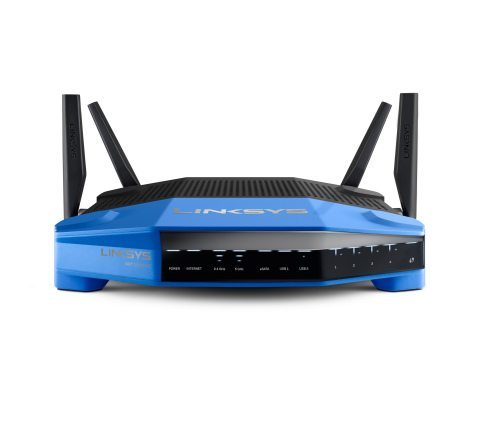—Comcast said its Xfinity Wi-Fi network now contains one million hotspots around the country, including its outdoor hotspots, hotspots for patrons at enterprises that Comcast includes for free with its business Internet service, and neighborhood hotspots where Comcast enables residential customers to have a second SSID that provides Wi-Fi access for Xfinity Internet subscribers without requiring the homeowner’s private network password.
—Linksys started shipping an 802.11ac router (pictured at right) designed for consumer use, priced at $280, at its online store and in Best Buy stores. The WRT1900AC was designed to call to mind the popular WRT54G home router that Linksys started selling 11 years ago, though the new model has four external antennas.
“The WRT is a cornerstone in the history of Wi-Fi and synonymous for many people with going wireless at home since it was their first wireless router. Since the introduction of the original WRT, we have sold more than 50 million units worldwide and are still selling it very successfully even with wireless technology advancing rapidly,” said Mike Chen, VP of product management for Linksys. “The WRT has a cult status for many because of the open source aspect that made it so immensely popular.”
Linksys has been collaborating with OpenWRT for months to ensure that the new router will also have well-developed open-source readiness and capabilities, the company said. The new WRT model is both 802.11ac certified and backwards compatible with 802.11a/b/g/n.
—IDC predicts that global revenue for cloud-managed Wi-Fi infrastructure and managed services will reach $653 million this year and $2.5 billion by 2018.
“Enterprises are seeing the big picture and definitely considering cloud-managed Wi-Fi for their remote sites when upgrading their networks,” said Rohit Mehra, VP of network infrastructure for IDC. “These upgraded network architectures can accommodate unique needs around ‘bring-your-own-device,’ scalability, application visibility and management.”
—ABI Research says 2014 could be “a breakout year for indoor location technologies in retail environments” as early adopters shift from trials to full-scale roll-outs. The firm expects to see more than 30,000 indoor location installations this year, and noted that both Wi-Fi and BLE/IBeacons are being used as new and lower-cost options for location services.
“We can clearly see major grocery and pharmacy chains really pushing towards this technology,” said Patrick Connolly, senior analyst with ABI. “These are very competitive verticals, which can benefit significantly from identifying and targeting loyal customers. Both already have large loyalty and advertising/offers deals in place and from a practical point of view, in-store items can be difficult to find. All of this makes indoor location a perfect fit.”
ABI added that in the fast food vertical, chains are testing indoor location technology because even a small percentage improvement in the length of customer lines can translate to millions of dollars for companies.
“With a number of initial trials now moving into full deployments, what we are seeing is broad regional and vertical adoption.” said Dominique Bonte, VP and practice manager at ABI. “The arrival of low-cost BLE beacons and Wi-Fi solutions will help to catalyze adoption in 2014, removing many of the [capital expenditure] barriers that exist. We are now seeing these technologies posing a major threat to the traditional [real-time location system] market, with a number of hospitals and corporate/enterprise customers assessing BLE to see if it can meet their requirements.”

